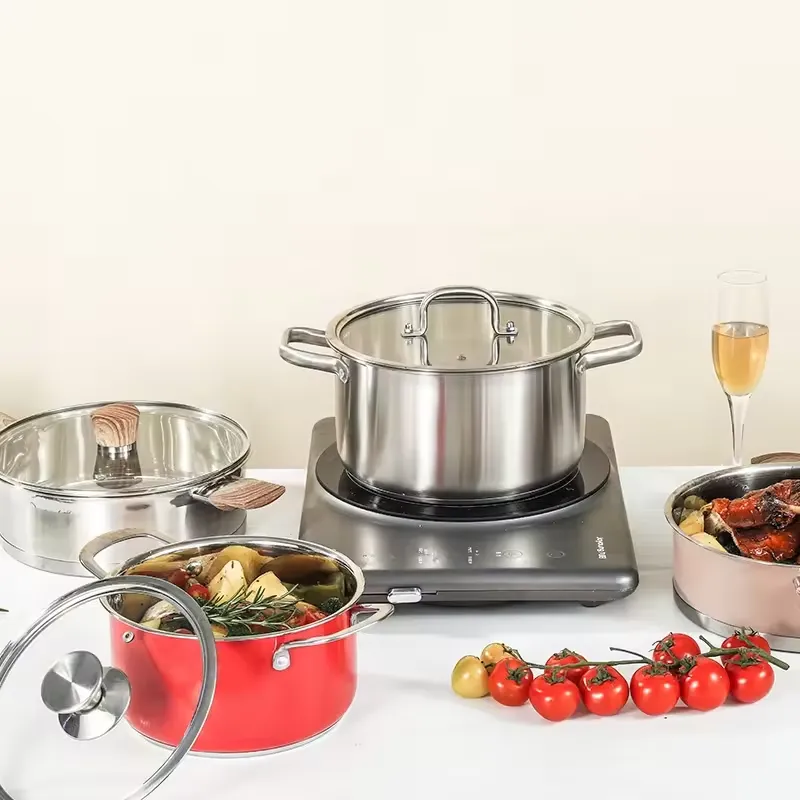Author:Roka
Many distributors or small and medium-sized buyers often need to choose between stainless steel cookware and aluminum cookware when choosing cookware products. Which one has better performance and can meet consumer expectations? In fact, these two types of cookware have their own advantages and disadvantages. As a cookware manufacturer with more than 30 years of manufacturing experience, I will take you to have a deep understanding of stainless steel cookware and aluminum cookware.
Today’s content is divided into three parts:
① Introduction to stainless steel cookware
② Introduction to aluminum cookware
③ Comparison between the two
Introduction to stainless steel cookware
Stainless steel cookware is widely used in home and commercial kitchens due to its durability, corrosion resistance and aesthetics. The following is a detailed overview of stainless steel cookware:
Features of stainless steel:
❶ Corrosion resistance: Stainless steel is an alloy composed of iron, chromium, nickel and other elements, and the chromium content is usually above 10.5%. Chromium reacts with oxygen in the air to form a dense chromium oxide layer to prevent further oxidation and corrosion.
❷ High strength and durability: Stainless steel has high hardness and strength, and can withstand greater mechanical pressure and impact without being easily deformed or damaged.
❸Non-reactive: Stainless steel resists most foods and condiments and does not react with acidic or alkaline foods, thus preserving the original flavor and ensuring food safety.
Advantages of stainless steel cookware:
❶Durable: Stainless steel cookware is very durable and can withstand long-term use without being easily damaged, suitable for frequent use and heavy-duty cooking environments.
❷Beautiful: Stainless steel cookware has a bright metallic luster, making it attractive and easy to match with various kitchen decoration styles.
❸Corrosion resistance: Stainless steel is resistant to water, acid and alkali, which prevents rust and corrosion, and stainless steel cookware is suitable for various cooking methods.
❹Easy to clean: Stainless steel has a smooth surface and is not easy to retain food and dirt, so stainless steel cookware is easy to clean and maintain.
Disadvantages of stainless steel cookware:
❶Poor thermal conductivity: Stainless steel is not as conductive as aluminum, resulting in slower and uneven heating. To improve this situation, many stainless steel cookware has an aluminum or copper layer embedded in the bottom. Our stainless steel cookware has a three-layer composite stainless steel plus aluminum bottom. By adding an aluminum layer between two layers of stainless steel, the stainless steel cookware has good thermal conductivity and can cook delicious dishes.
❷Heavy weight: Due to its higher density, stainless steel cookware is usually heavier than aluminum cookware and requires more effort when using.
❸Higher cost: Due to its higher production cost, stainless steel cookware is usually more expensive.
Common types of stainless steel cookware
❶ Stew pots and stock pots: Stainless steel stew pots and stock pots are ideal for making soups and stews, durable and easy to clean.
❷ Frying pans and woks: Suitable for various cooking methods such as frying, stir-frying, boiling and stewing.
❸ Knives: Stainless steel knives are sharp and durable.
Our stainless steel cookware:
We wholesale various types of stainless steel cookware, including stew pots, soup pots, frying pans, and woks. and provide customized cookware solutions for brands and buyers.These cookware all use a three-layer composite bottom, which gives them all the advantages of stainless steel and good thermal conductivity.
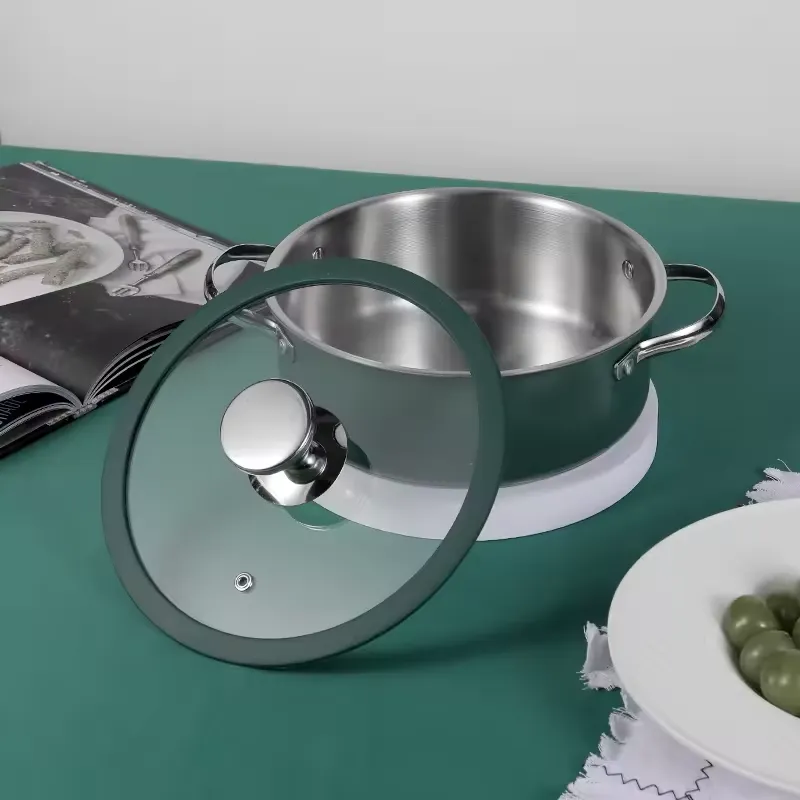
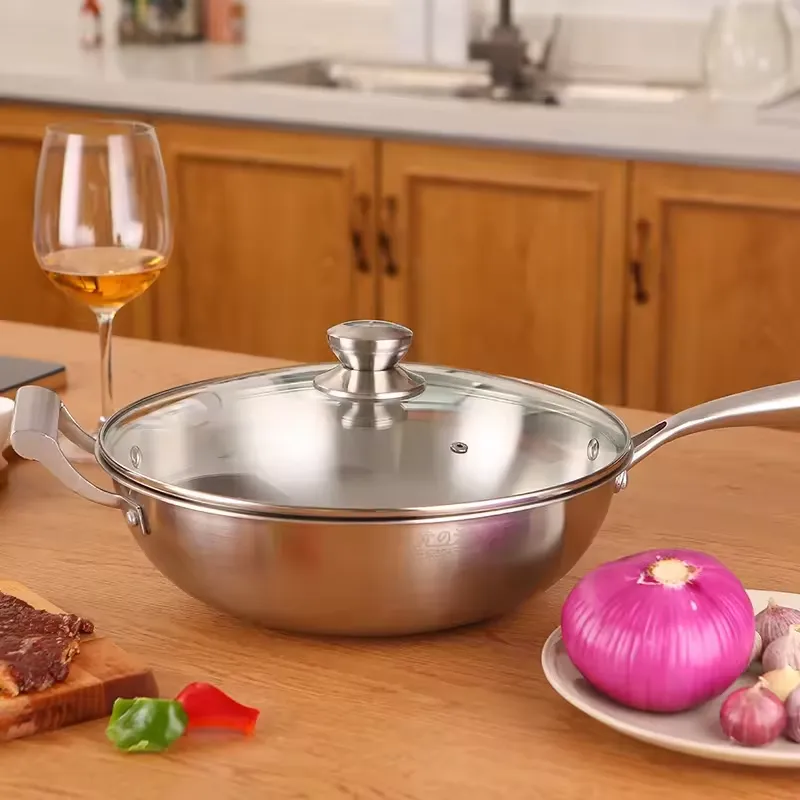
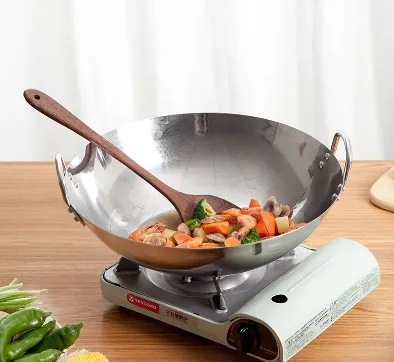
Introduction to aluminum cookware
Aluminum cookware is a common choice for home and commercial kitchens due to its unique material properties and a wide range of applications. Here is a detailed overview of aluminum cookware:
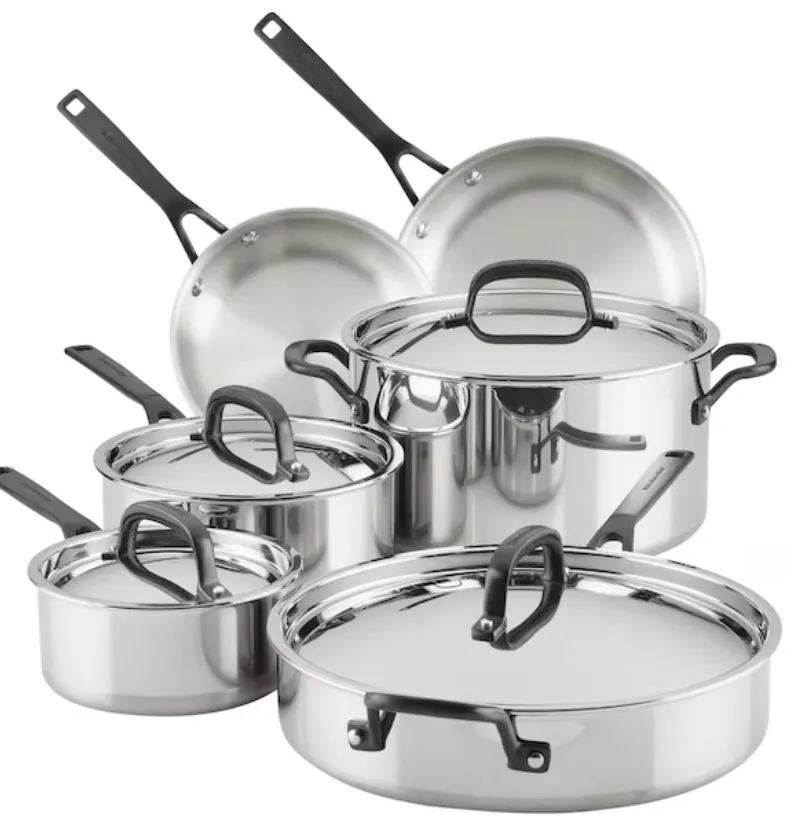
Features of aluminum:
❶ Lightweight: With a density of about 2.7 grams per cubic centimeter, aluminum is much lighter than stainless steel and other metals, making it easier to handle.
❷ Good thermal conductivity: With a thermal conductivity of up to 235 W/(m·K), aluminum heats up quickly and evenly, making it ideal for cooking processes that require fast and even heating.
❸ Corrosion resistance: When aluminum is exposed to air, a dense oxide layer forms on the surface, effectively preventing further oxidation and corrosion.
Advantages of aluminum cookware:
❶ Fast and even heating: High thermal conductivity allows food to heat quickly and evenly, reducing cooking time and increasing energy efficiency.
❷ Lightweight and easy to handle: Due to its light weight, aluminum cookware is easier to handle, making it ideal for cooking methods that require frequent moving and flipping.
❸ Cost-effective: Aluminum is abundant and relatively inexpensive to produce, so aluminum cookware is generally more affordable.
Disadvantages of aluminum cookware:
❶ Soft and easy to deform: Aluminum is relatively soft and can be easily scratched or deformed during use, making it unsuitable for heavy-duty or high-intensity cooking environments.
❷ Chemical reactivity: Bare aluminum reacts with acidic or alkaline foods, which may affect the taste and health of the food. To address this issue, many aluminum cookware are coated with a protective layer (such as anodized aluminum or non-stick coating).
❸ High maintenance requirements: Aluminum cookware requires careful maintenance to avoid scratching the protective coating and ensure long-term use.
Common types of aluminum cookware:
❶ Frying pans and woks: Aluminum frying pans and woks heat up quickly and are suitable for frying food.
❷ Stock pots and stock pots: Aluminum stock pots and stock pots distribute heat evenly and are ideal for stewing soups and stews.
❸ Baking trays and oven trays: Aluminum baking trays are lightweight and have excellent thermal conductivity, making them suitable for baking food.
Comparison of Stainless Steel Cookware and Aluminum Cookware
Stainless steel cookware is known for its durability, beauty, easy cleaning and high safety, and is an indispensable choice in the kitchen. Although the thermal conductivity of stainless steel is relatively poor compared to aluminum cookware, by adding three layers of stainless steel containing an aluminum layer to the bottom of the stainless steel cookware, it can also have good thermal conductivity. The comprehensive performance is better than that of traditional stainless steel cookware and aluminum cookware. For example, our PURECOOK stainless steel cookware, whose multi-layer bottom is embedded with an aluminum layer, can improve its thermal conductivity and has perfect performance in the designed cooking. On the other hand, aluminum cookware has become a common choice in the kitchen due to its light weight, good thermal conductivity and affordable price. Aluminum cookware is soft and highly chemically reactive, so it requires more correct use and maintenance.
That’s all for today’s sharing! We hope that this information will help you better understand the difference between aluminum and stainless steel cookware, help you make a wise choice, and effectively use these tools to improve your cooking experience and kitchen efficiency!
How to tell aluminum from stainless steel cookware
The first criterion is weight. Stainless steel has a higher density, so cookware is usually heavier. Aluminum has a lower density, so cookware is relatively light. Therefore, if the cookware is lighter, it is often aluminum cookware, and the opposite is stainless steel cookware.
The second criterion is the appearance color. Stainless steel cookware is usually more shiny and has a bright metal texture. The surface of aluminum stainless steel is matte.
The third criterion is to judge by the label. The label often indicates the type of cookware. You may see words such as “Stainless Steel” or “Aluminum”.
The fourth criterion is to judge by the knocking sound. When stainless steel cookware is knocked, the sound is duller and the metal reverberation time is shorter. When aluminum cookware is knocked, the sound is crisper and the reverberation time is longer.

